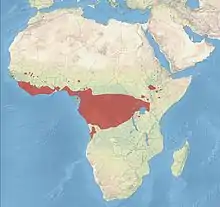Black-and-white mannikin
The black-and-white mannikin (Spermestes bicolor) or black-and-white munia, is a species of estrildid finch, widely occurring throughout the African tropical rainforest. It has an estimated global extent of occurrence of 4,200,000 km2. It is found in moist savanna and subtropical or tropical moist lowland forest habitat. The status of the species is evaluated as least concern. They are seedeaters, but are known to feed on algae.[3]
| Black-and-white mannikin | |
|---|---|
_(7699911414)%252C_crop.jpg.webp) | |
| In Douala, Cameroon | |
| Scientific classification | |
| Kingdom: | Animalia |
| Phylum: | Chordata |
| Class: | Aves |
| Order: | Passeriformes |
| Family: | Estrildidae |
| Genus: | Spermestes |
| Species: | S. bicolor |
| Binomial name | |
| Spermestes bicolor (Fraser, 1843) | |
 | |
| distribution[2] | |
Origin
Origin and phylogeny has been obtained by Antonio Arnaiz-Villena et al.[4] Estrildinae may have originated in India and dispersed thereafter (towards Africa and Pacific Ocean habitats).
References
| Wikimedia Commons has media related to Lonchura bicolor. |
- BirdLife International (2012). "Lonchura bicolor". IUCN Red List of Threatened Species. 2012. Retrieved 26 November 2013.CS1 maint: ref=harv (link)
- Map based on IUCN data
- Savalli, U.M. (1989) Black and White Mannikins Lonchura bicolor eating algae. Scopus 13: 136.
- Arnaiz-Villena, A; Ruiz-del-Valle V; Gomez-Prieto P; Reguera R; Parga-Lozano C; Serrano-Vela I (2009). "Estrildinae Finches (Aves, Passeriformes) from Africa, South Asia and Australia: a Molecular Phylogeographic Study" (PDF). The Open Ornithology Journal. 2: 29–36. doi:10.2174/1874453200902010029.
This article is issued from Wikipedia. The text is licensed under Creative Commons - Attribution - Sharealike. Additional terms may apply for the media files.
